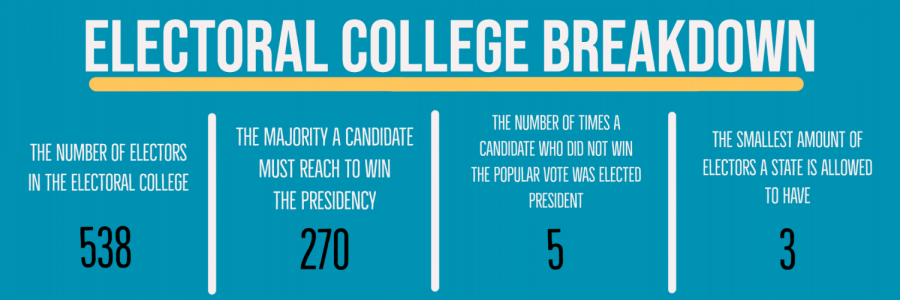Opinion: The electoral college should be abolished
November 4, 2020
One of the most pressing issues of our time and for generations to come is the system we use to elect the president of the United States. The electoral system currently employed in the U.S. is a disgrace to our democracy and the values that American citizens live by.
The Electoral College was established in 1788 in Article II of the Constitution as a compromise between the Founding Fathers. A popular vote system was considered, as was Congress electing the president, but the fathers agreed that the Electoral College was the optimal system.
In each state, the amount of electors is based on the number of senators and representatives each state has in congress; Wyoming is given three electoral votes, while California is given 55. The Electoral College is composed of 538 electors, meaning any given candidate must win 270 electoral votes in order to become the next president.
Most states have a winner-take-all system, meaning all of the electors must cast their votes for the political party who wins the most votes in their state. However, in Nebraska and Maine, the political party that wins the popular vote is given two electors, and the other electors vote based on specific congressional districts.
In creating this system, the philosophy of the Founding Fathers was that the people were too incompetent to vote directly and did not have enough information to make informed decisions. In addition, the Founding Fathers who lived in the southern states believed the northern states would overtake them in regards to popular vote, and they would have no say in the election.
However, these reasons are not applicable today. Because the world we live in is based on the internet and social media, most people have enough information to make an informed decision. Also, there are more states than when the constitution was ratified, meaning that one half of the country does not have more influence than the other.
In addition, the Electoral College overrides the will of the people to decide the president. If one candidate receives more overall votes than the other, the country favors that person to be their president. However, with the current electoral system, situations can occur in which a candidate wins the popular vote, but they are not sworn into the office of the president on Jan. 20.
This situation occurred in the most obscene fashion in the 2016 presidential election. Democratic nominee Hillary Clinton won the popular vote by a large margin of almost 3 million votes, but the system allowed Republican nominee Donald Trump to take the office of the president.
Trump was able to win the election through the number of states he won, rather than the number of overall votes. By winning swing states such as Pennsylvania and Michigan, Trump was able to make it over the electoral threshold even while states like New York and Maryland were not even close in Trump’s favor.
For example, in an overwhelmingly blue state such as California, 55 electoral votes represent a population of 39 million people. However, in a red state such as Wyoming, 3 electoral votes represent only 587 thousand people.
This means that each vote in Wyoming is 3.18 times more significant than a vote in California. This system encourages less voter turnout because states such as California and Wyoming vote overwhelmingly for one party no matter what and they will not decide the outcome of the election. The emphasis is only on the small percentage of swing states which candidates must win in order to secure a majority.
The electoral system plays out in the Republican’s favor. Republican candidates are not as easily able to win the overall popular vote, but the electoral college allows them to win more states without winning more votes. Democratic Candidates have won the popular vote in five out of the last six elections; however, Republicans have won three out of the last six elections. This is also true for the Senate, in which 53 Republican Senators represent 11 million fewer people than the 47 Democratic senators.
This came into play recently in the confirmation vote of new Supreme Court Justice Amy Coney Barrett, in which she was nominated by a president who lost the overall vote. Then, she was confirmed by 52 senators representing fewer Americans than their colleagues who voted against the nomination. This nomination cemented a Supreme Court majority for conservatives against the wishes of the country.
It has become an issue that a political party, such as the Republican party, can stay in power even while they have a minority overall to the Democratic party. More Americans are Democrats, but more people in power are Republicans, meaning we live in a country in which the people in power are a minority.
As the election comes to a close today in which Democrat Joe Biden will take on incumbent president Trump, keep in mind that the system needs to progress to meet our needs as a changing nation. Policies that were created 200 years ago are meant to be changed and amended when necessary. I would say that a change to our electoral system is as necessary as ever in our polarized political climate.


















